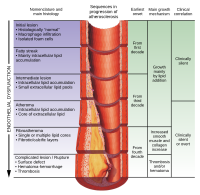
Photo from wikipedia
Purpose18F-FDG PET/CT (PET/CT) is a useful tool for the diagnosis of aortic graft infection (AGI), but has rarely been used to influence therapeutic decisions during follow-up. We aimed to study… Click to show full abstract
Purpose18F-FDG PET/CT (PET/CT) is a useful tool for the diagnosis of aortic graft infection (AGI), but has rarely been used to influence therapeutic decisions during follow-up. We aimed to study the role of PET/CT in the long-term monitoring of patients.MethodsParticipants of the prospective Vascular Graft Infection Cohort Study (VASGRA) were included if they had microbiologically proven AGI. We quantified the metabolic activity in PET/CT by using maximum standardized uptake value (SUVmax) and further classified it as being focal or diffuse. Multivariable linear regression models were fit using generalized estimating equations to investigate factors associated with SUVmax over time.ResultsSixty-eight participants with AGI contributed to 266 PET/CTs including 36 examinations performed after stop of antimicrobial therapy. Higher C-reactive protein (CRP) (adjusted coefficient per log10 mg/L 0.05 [95% C.I. 0.02–0.08]) was associated with higher SUVmax. CRP, metabolic and clinical findings informed the decision to either start (medians of SUVmax 7.1 and CRP 31.5 mg/L; 100% focal uptake), escalate (SUVmax 9.5; CRP 31.5; 100% focal uptake), continue (SUVmax 6.0; CRP 9.95 mg/L; 90% focal uptake), or stop (SUVmax 4.3; CRP 3.5 mg/L; 61% focal uptake) antibiotic treatment. Of note, decisions to escalate or continue antibiotic treatment were taken despite normal CRP values in 12.5 and 35.7% of PET/CTs, respectively.ConclusionsConsecutive PET/CTs could influence the clinical decision-making in patients with AGI in the near future. More studies on the use of PET/CT in case of aortic graft infection may offer the potential for individualized treatment approaches.CLINICALTRIALS.GOV IDENTIFIERNCT01821664.
Journal Title: European Journal of Nuclear Medicine and Molecular Imaging
Year Published: 2018
Link to full text (if available)
Share on Social Media: Sign Up to like & get
recommendations!